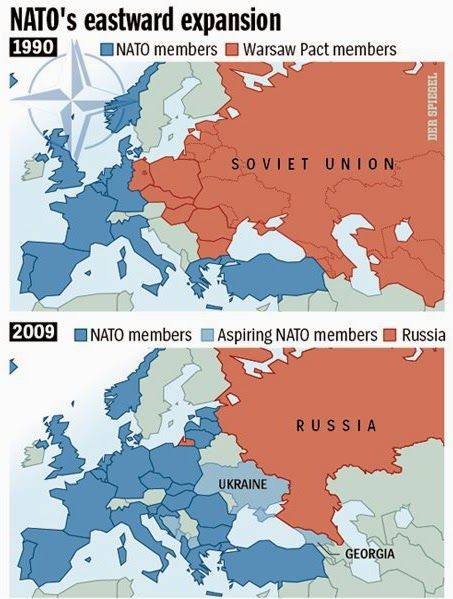For decades we’ve been saying “war is obsolete.” There are much better ways to resolve conflicts, without resorting to killing and maiming other human beings. And, besides, in the nuclear age, the stakes are far too high to risk confrontation that could lead to humanity’s annihilation.
That said, we find ourselves once again near the brink of a conflict that could
end up involving the U.S. and Russia, the two nations that collectively possess
more than 90 percent of all nuclear weapons. It’s time to explore how we got
here and how we might escape unscathed and avoid situations like this in the
future.
First of all, we are pleased that President Biden has ruled out sending U.S.
troops to Ukraine. We support his declaration “We continue to
urge diplomacy as the best way forward . .
.” That said, we also need to look at what’s being offered up as potential
diplomatic solutions.
This conflict is more complicated than it appears on the
surface. To begin with, until 30 years ago, Ukraine had been part of the same
nation as Russia for hundreds of years. Approximately 30 percent of Ukraine’s
population is ethnically Russian. And Ukraine has a land border of more than
1,200 miles with Russia, and a sea border of 200 miles.
To further contextualize this, Russia has been invaded repeatedly from the west.
After World War II, in which the Soviets lost more than 24 million lives, they
sought to insulate themselves by organizing the Warsaw Pact, a coalition of the
U.S.S.R. and seven Eastern European states. The Western powers organized the
North Atlantic Treaty Organization (NATO) as an anti-Soviet alliance. Each
coalition attempted to portray itself as defensive, and as committed to common
values, be that democracy in the West or socialism in the East.
When the Berlin Wall came down, U.S. Secretary of State Jim Baker met with
Soviet President Gorbachev and promised him that, if East Germany was allowed
to rejoin West Germany and be part of NATO, that the western alliance would not
incorporate any other states in Eastern or Central Europe. “Not one inch
eastward” was Baker’s promise. Since that time, NATO has grown from 16 states
to 30; incorporating 14 states, most that were formerly part of the Warsaw Pact
or, in the case of the Baltics, part of the U.S.S.R. itself.
Many, including Peaceworks, question why, in the post-Cold War period there was
a need to maintain NATO, much less expand it. We also question why, back in the
1990s the U.S. did not seek to build an alliance with the emerging Russian
Federation. Perhaps, if the U.S. had treated Yeltsin’s Russia with respect and
partnership, Putin would never have come to power.
We also question why, NATO states are required to spend at least two percent of
their gross domestic product on their militaries. This is a boon to the
Military Industrial Complex, always eager to sell our governments the latest,
greatest weapons systems, but it doesn’t address the real threats to our
security, such as climate change.
While we strongly condemn Russia’s massing of troops on Ukraine’s border, we
also understand Russia’s objection to Ukraine joining NATO. We can only imagine
how the U.S. would react to a hostile power installing its military on our
borders. We also think the time has come to reconsider NATO’s utility and to
look at what might be done to usher in a common security framework for Europe
and the North Atlantic. It’s time to outgrow being enemies and exploring our
shared interests.
As to defusing the current conflict, that’s not easy, as neither side wants to
lose face, but it is doable. It can begin with an agreement that the Russians
will pull back their troops, and deploy them in a defensive posture. NATO would
agree to a moratorium on adding new members, while all parties would agree to a
collective exploration of a Common Security framework that could ultimately
replace NATO or any other military alliances, and allow the negotiation of
mutual, verifiable reductions in nuclear arsenals as well as offensive
conventional weapons.
Common Security is based on the premise that “International Security must rest on a
commitment to joint survival rather than a threat of mutual destruction.” Click HERE for more info. The current crisis can also be an opportunity. We can turn to diplomacy instead
of the use, or the threatened use, of weapons. This could be a beginning step
toward a more peaceful future. But it will take vision and the willingness on
all sides to move away from war and militarism.
